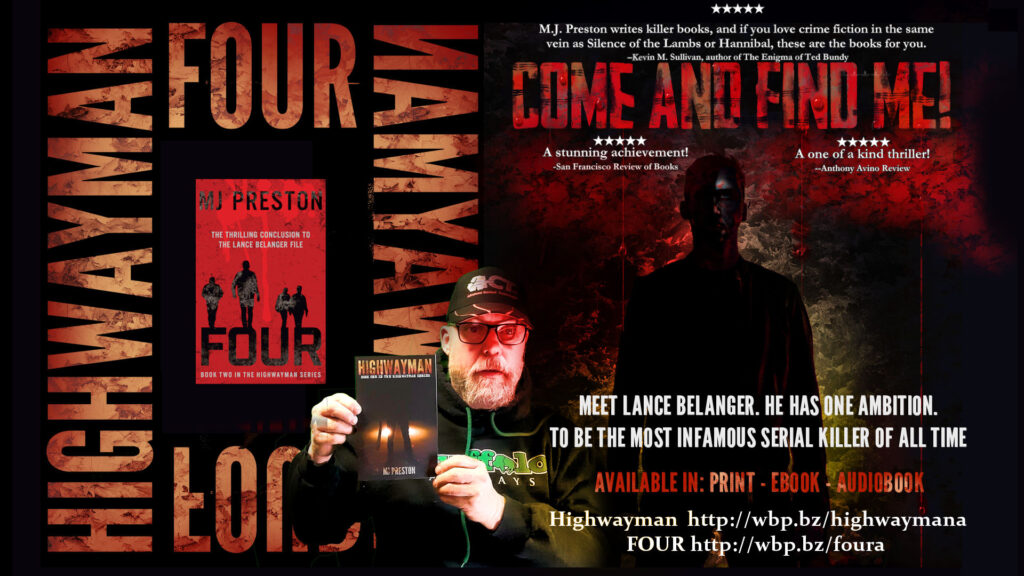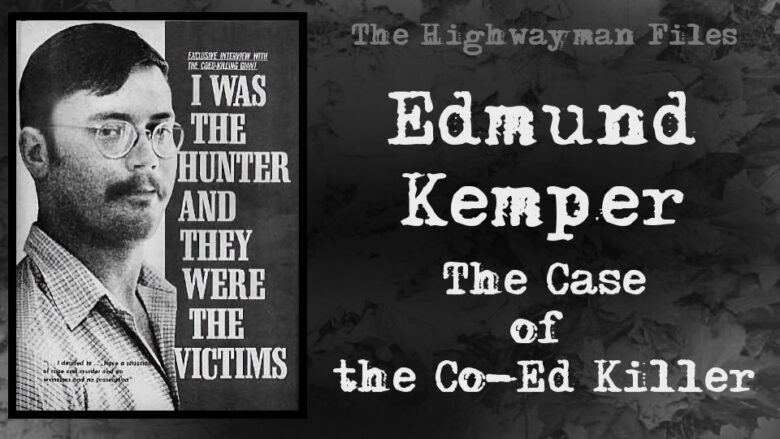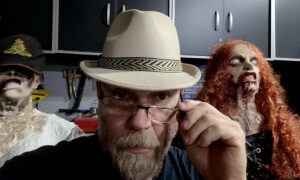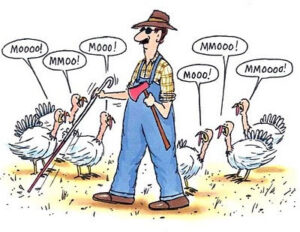PART II – THE CASE OF THE COED KILLER
When I decided to start the Highwayman series, I spent most of the creation process in the cab of a truck running up and down the road turning over ideas in my head. I coupled this with research, sometimes on audiobooks, reading true crime, and watching documentaries on the subject.
HIGHWAYMAN is a two-book project which follows the birth and evolution of a serial killer named Lance Belanger. When I started this project, I was faced with a couple of questions. The first was, “How do I want my character to be?” That’s an open-ended question. I mean, do I want Lance to be sympathetic or just plain evil? Most serial killers are evil people, but what really makes them tick? What is their reasoning for doing what they do? How do they compartmentalize their acts, and what emotions do they have that the reader can identify with?
In the case of HIGHWAYMAN, Lance Belanger knows that he is different. He shares in many of the aspirations of ordinary members of society. He has wants, needs, insecurities, and he also has regrets. While we share many of those traits, our interpretations of our wants and needs are limited by the lengths we will go to accommodate those needs. For instance, if a normal person sees something they desire, they are usually defined by an internal moral compass. They will not cross the line to steal, or rape or murder. But let’s be honest. We’ve all had thoughts. Maybe about someone we don’t like or have been slighted by. We might think, “I’d like to bash that person’s head in.” But we don’t act on it, because internally we know that is wrong. The same goes for stealing or acting on lust.
†
The true sociopath lacks that moral compass and is driven by a need to do the unthinkable. Case in point would be the incarcerated California Coed Killer, Edmund Kemper. Kemper was imprisoned twice for murder. On August 27, 1964, Edmund Kemper, then 15, got into an argument with his grandmother, took a rifle his grandfather had given him and shot her dead. What made Kemper cross that line is anybody’s guess. Having read about him and based on interviews he gave to FBI agents, Robert Ressler and John Douglas, I have come to the assumption that part of it was seeded in his feelings of inadequacy around women. Kemper had a strong bond with his father but was always at odds with his mother. When they divorced, Kemper lost the only person he could relate to, or that was his explanation. After killing his grandmother, he waited for his grandfather to return and shot him as well. Presumably, because grandpa would have been a witness? That might have been it, except Kemper then called his mother and confessed to the crimes. She urged him to call the police and turn himself in. He did and was taken into custody.
Edmund Kemper had already crossed the line into the world of murder, but between 1969 and 1972 it appeared that Kemper was getting his life on track. He became briefly engaged to a 16-year-old high school student, worked for the Department of Highways and purchased a 1969 Ford Galaxy after receiving a $15,000.00 settlement for a motorcycle accident he’d been involved in.
But all was not as it seemed. Kemper began to take notice of the pretty California coeds hitchhiking in and around the university his mother worked at. In the trunk of his Ford, he kept instruments of murder and disposal. Bags, knives, guns, and handcuffs. He began dry runs, in which he would pick up female hitchhikers and let them go while easing just a little closer to his murderous fantasies.
On May 7th, 1972, fantasy morphed into reality when he picked up Mary Ann Pesce and Anita Luchessa. After driving to a secluded spot, Kemper handcuffed, raped and murdered both women. He then placed their bodies into the trunk of his car, and returned to his apartment where he took photos, dismembered their bodies, and had sex with their severed heads. He then drove out to Santa Cruz and disposed of them into a ravine on Loma Prieta Mountain. Pesce’s skull was recovered the following August, but the rest of her body and the remains of Luchessa were never recovered.

Kemper would go on to abduct, rape, kill and defile the corpses of his victims. On September 14th he murdered, Aiko Koo, a Korean dance student who had opted to hitchhike to class after missing her bus. On January 7th, 1973 he shot and killed Cindy Schall, who he decapitated and after keeping her head for a few days, he buried it in the garden at his mother’s home. The following month, February 5th, after a heated argument with his mother, Kemper abducted and killed Rosalind Thorpe and Allison Liu. Again, Kemper removed their heads and used them in his depraved sexual ritual. He disposed of them at Eden Canyon.
On April 20, 1973, Kemper’s mother, Clarnell Strandberg, returned from a party and her son, who was again living in her home, entered her bedroom. According to Kemper, his mother was indifferent, saying, “I suppose you’re going to want to sit up all night and talk now.”
Kemper said, “No.” Then withdrew from the room and waited for his mother to fall asleep.
He returned with a claw hammer and bludgeoned her to death in her bed. He then had sex with her head, placed it into his closet and purportedly yelled at it for an hour. He would commit other indignities, including cutting out her tongue and larynx which he attempted to destroy in the garbage disposal. He then left his mother’s home to drink and returning some hours later he invited his mother’s best friend, Sara Taylor Hallett, to come over. When she arrived, he attacked and killed her, then defiled and had sex with her corpse. After depositing her body in a closet, Kemper took Hallett’s car and fled California, driving through Nevada and Utah into Pueblo, Colorado. It was there he found a pay phone and contacted authorities. At first, they didn’t take him seriously and asked him to call back. After a few hours, Kemper did call back, asking for an officer he knew and again confessed to the murders of his mother, her friend, and the missing coeds.

After turning himself in and confessing to his crimes, Kemper received concurrent sentences of 7 years for each victim. He has repeatedly been denied parole and waived future hearings. Kemper stated that his murderous rampage ended with the killing of his abusive mother but claimed that he would still pose a danger to society.
In interviews with FBI agents, Robert Ressler and John Douglas, Kemper was extraordinarily forthcoming and likable. He stated that the only reason he was incarcerated was that he turned himself in. His words, “Came in out of the cold.” But Kemper would have been caught, the bodies of his mother and her best friend would eventually be found and link him to the crimes.
Ressler, in his book WHOEVER FIGHTS MONSTERS, spoke of how comfortable both he and Douglas had become with Kemper. This would later prove to be a poor judgment as Ressler, who was alone with Kemper, wrapped the latest interview and was waiting for the guards to let him out. After ringing the bell, with no response, Ressler waited uneasily.
That was when Kemper told him, “Relax, they’re changing shifts, feeding the guys in the secure areas. Might be fifteen, twenty minutes before they come and get you.” After pausing, Kemper said something that alarmed Ressler. “If I went apeshit in here, you’d be in a lot of trouble. I could screw your head off, and place it on the table to greet the guard.”
For the next 30 minutes, until the guards arrived, Kemper and Ressler jousted verbally. Ressler stating that FBI Agents don’t come to interviews unprepared. While Kemper countered, “They don’t let anybody bring guns in here.”
Kemper was a giant of a man, who could have easily overpowered and killed Ressler. After that, the FBI instituted a policy that two agents were to be with a prisoner during all future interviews.

FOUR http://wbp.bz/foura
That communication, with the likable forthcoming Edmund Kemper, was a wakeup call regarding psychopaths. They are master manipulators, disarming is a part of their arsenal, and it wasn’t the first time Kemper used his charm. After abducting Aiko Koo, Kemper locked himself out of the Ford Galaxy but managed to convince Koo to let him back into the car. He killed Koo after regaining entry to the vehicle. Gaining the trust of his victims and authorities is something Kemper does very well. The interaction between the two, in those very long 30 minutes, fed into one of Kemper’s fantasies of instilling fear.
FBI agent, Robert Ressler died May 5th, 2013, after a lengthy battle with Parkinson’s Disease. Edmund Kemper remains at the California Medical Facility in Vacaville, California. He is considered a model prisoner, who narrates audio books for the blind. It is unlikely he will ever be released.
Kemper is one of a long list of serial killers who I researched when I decided to start the HIGHWAYMAN BOOKS. What stuck out for me was the relaxed nature of this man responsible for the killing of 10 known victims. What also resonated was his ability to manipulate his psychiatrists, both while incarcerated and even the psychologist who treated him during his release and run up to the coed killings. They didn’t have a clue. Kemper, like Ted Bundy, had a charm that hid the horrific intentions of the monster lurking behind the mask. In jailhouse interviews for the documentaries, THE KILLING OF AMERICA and NO APPARENT MOTIVE, Kemper is charming, engaging and comes off as cured of his homicidal tendencies, having ended them with the killing of his mother and turning himself in. But that is the mask he wears, and the monster that feeds on his fantasies is alive and well.
In the present day, we have turned some of these killers into pop culture icons. Charles Manson’s glowering face can be found on silk-screened shirts and posters. Fictional characters like Dexter Morgan portray sympathetic serial killers, driven to kill while conflicted by a moral code. Then there’s Edmund Kemper, who has been made a household name after the release of the NETFLIX semi-fictional series MIND HUNTER. I say semi-fictional because screenwriters have taken a lot of liberty with the original book written by John Douglas and Mark Olshaker. Make no mistake, I am not being self-righteous. I have no illusions that these are the monsters that inspire fiction. But I will admit that I was disappointed with the deviation and historical errors purposely written into the Mind Hunter storyline.
We, writers, draw from a pond of murder and mayhem to create the fictional characters in our stories. Or at least I do. Edmund Kemper was one among many subjects which I researched before beginning the Highwayman project.
In my next blog, I will be visiting another case from those research files.
See you then.
M.J. Preston

Highwayman http://wbp.bz/highwaymana
FOUR http://wbp.bz/foura



